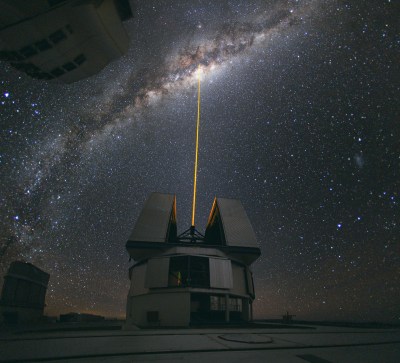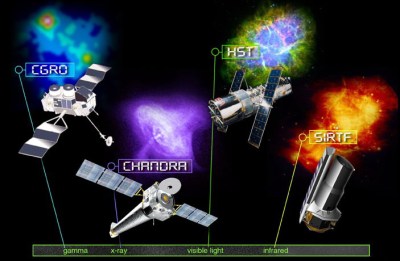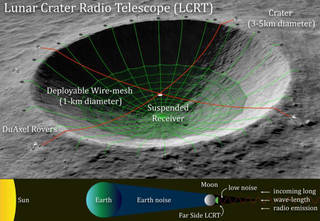More Than Just Hubble: the Space Observatories Filling The Skies Today And Tomorrow

Amidst the recent news about the Hubble Space Telescope’s troubles (and triumphant resurrection), it is sometimes easy to forget that although Hubble is a pretty unique telescope, it is just one of many space-based observatories that are currently zipping overhead right now or perched in a heliocentric orbit. So what is it that makes these observatories less known than the iconic Hubble telescope?
Hubble is one of the longest-lived space telescopes so far, and it is also the only space telescope that was both launched and serviced by the Space Shuttle. None of the other telescopes have this legacy, the high-profile, or troubled history of Hubble’s intended successor: the James Web Space Telescope (JWST).
Even so, the mission profiles of these myriad other observatories are no less interesting, least of the many firsts accomplished recently such as a long-term moon-based telescope (Chang’e 3’s LUT) and those of the many upcoming and proposed missions. Let’s take a look at the space observatories many of us have never heard of.
Why Telescopes Don’t Like People

The obvious question with space-based telescopes is ‘why?’. As in, why go through all the trouble of getting a package of generally rather fragile instruments up into space, instead of building a nice, big observatory on Earth where transporting the equipment and building materials can be done by truck and ship, rather than per rocket? Part of the answer can be found in the locations picked by those Earth-based telescopes.
The presence of people means light pollution, radio-frequency pollution (for radio telescopes) and other unwanted influences. Additionally, the thicker the atmosphere between the telescope and space, the worse effects like atmospheric scintillation (‘twinkling stars’) are likely to be. While strategies such as adaptive optics (AO) and simply placing observatories on top of mountains far away from society help to mitigate many of these issues, they do not address some annoying features of the Earth’s atmosphere.
While the Earth’s atmosphere is absolutely great for us biological critters in that it blocks most UV radiation, X-rays, and attenuates infrared and other parts of the electromagnetic radiation spectrum, this is obviously rather undesirable when trying to observe the universe in those parts of the EM spectrum. Although airborne observatories on airplanes such as NASA’s SOFIA or balloons help a bit here, in order to get a good look at everything the universe has to offer, one has to venture into space to get an unobstructed view.
The Great Observatories

Hubble is part of NASA’s Great Observatories program, which includes the Hubble, Chandra, Compton, and Spitzer space-based observatories. The roots for this program go as far back as 1946, when astronomer Lyman Spitzer wrote a paper (PDF) that was published on July 30th, 1946 on the advantages of space-based observations over terrestrial ones.
Without the blurring effect of the Earth’s atmosphere and the blindfold-like effect which the same atmosphere induces with UV, X-ray and other types of measurements, humanity’s knowledge and understanding of the universe, our galaxy and nearby planets could be expanded in ways previously deemed inconceivable. With the NASA Orbiting Astronomical Observatory 2 (AOA-2, nicknamed Stargazer) space observatory that launched in 1968 the feasibility of such an observation platform was confirmed.
Essential to an observatory is the ability to focus on a target for extended periods of time, which in space is enabled through star trackers, which enable a spacecraft to maintain a fixed orientation relative to e.g. stars. These enabled Stargazer to focus its Vidicon-derived UV-sensitive camera tubes (Uvicon) on a research target to get a clear picture. When Stargazer‘s mission ended in 1973, similar missions such as X-ray observatory Uhuru had been launched as well, and beyond NASA other space organizations around the world would launch their own space-based observatories.
Where the Great Observatories are unique is in that all four were designed to be complementary, covering the entire spectrum from visible light and near-IR (Hubble), to IR (Spitzer), X-ray (Chandra) and gamma radiation (Compton). This provided observations that were impossible back in the 1990s with ground-based observatories and which in many cases are still impossible today, due to the aforementioned effects of the Earth’s atmosphere.
Today, only Hubble and Chandra remain active. Compton’s mission ended in 2000 after 9 years and 2 months when it was intentionally deorbited after one of its three gyroscopes had failed. Spitzer’s mission ended on January of 2020, after 16 years and 5 months. Even though it had already run out of coolant for far-IR observations by 2009, a limited mission profile was continued until the shutdown signal was sent in 2020. Spitzer will continue to drift along a heliocentric orbit in this shutdown state.
Traffic Jams in Space
At this point in time, there are over twenty active space-based observatories. Roughly split by their primary capabilities, these are:
Gamma-Rays:
- International Gamma-Ray Astrophysics Laboratory (INTEGRAL, geocentric).
- Fermi Gamma-ray Space Telescope (formerly GLAST, geocentric LEO).
- Astrorivelatore Gamma ad Immagini Leggero (AGILE, geocentric LEO).
- Neil Gehrels Swift Observatory (Swift, geocentric LEO).
- Gamma-Ray Burst Polarimeter (GAP, onboard IKAROS, heliocentric, possibly lost).
X-Rays:
- Chandra X-ray Observatory (formerly AXAF, geocentric highly elliptical).
- X-ray Multi-Mirror Mission (XMM-Newton geocentric).
- Nuclear Spectroscopic Telescope Array (NuSTAR, geocentric near-equatorial).
- Astrosat (geocentric near-equatorial).
- Hard X-ray Modulation Telescope (HXMT, geocentric LEO).
- Spektr-RG (Sun-Earth L2 Lagrange point).
UV & Visible Light:
- Hubble Space Telescope (geocentric LEO).
- Interface Region Imaging Spectrograph (IRIS, geocentric sun-synchronous).
- Hisaki (also known as SPRINT-A, geocentric LEO).
- Lunar-based Ultraviolet Telescope (LUT, Lunar surface).
- Bright-star Target Explorer (BRITE, geocentric).
- Near Earth Object Surveillance Satellite (NEOSSat, geocentric sun-synchronous).
- Gaia (Sun-Earth L2 Lagrange).
- Transitioning Exoplanet Survey Satellite (TESS, high Earth elliptical orbit).
- Characterising Exoplanets Satellite (CHEOPS, geocentric sun-synchronous).
Infrared:
- Wide-field Infrared Survey Explorer (WISE, geocentric sun-synchronous).
Microwave:
- Odin (geocentric LEO).
Particle Detection:
- Interstellar Boundary Explorer (IBEX, geocentric HEO).
- Alpha magnetic Spectrometer (AMS-02, attached to ISS).
- Dark Matter Particle Explorer (DAMPE, sun-synchronous).
More to Come
While some of the observatories from the active list will soon be deorbited or deactivated as they reach the end of their mission or overall lifespan, there are around a dozen new missions which we should be able to welcome over the coming years, starting this year with no fewer than three:
- Imaging X-ray Polarimetry Explorer (IXPE, X-ray, geocentric LEO).
- James Web Space Telescope (JWST, UV/visible/IR, Sun-Earth L2 Lagrange halo orbit).
- X-ray Polarimeter Satellite (XPoSat, X-ray, geocentric).
These will be followed by no fewer than four new missions:
- X-Ray Imaging and Spectroscopy Mission (XRISM, X-ray, geocentric LEO).
- Aditya-L1 (Solar observation, Sun-Earth L1).
- International Lunar Observatory (ILO-1, visible, Lunar South Pole).
- Euclid (visible/near-IR, Sun-Earth L2).

Of these the ILO-1 mission is both perhaps the most exciting as it will create the second permanent Lunar observatory after Chang’e 3’s LUT and add visible observations to LUT’s ultraviolet. Although details are somewhat sketchy, it appears that the ILO-X exploration mission may launch on a Nova-C lunar lander designed by Intuitive Machines. The IM-1 mission would be launched on a SpaceX Falcon 9 rocket in early 2022, with ILO-1 targeting IM-2 for late-2022.
Regardless of whether ILO-1 works out, NASA is also eyeing the Moon for a telescope. This would be the Lunar Crater Radio Telescope (LCRT) and be the biggest in the solar system at 1 kilometer in diameter. The LCRT would allow for radio observations of the universe at wavelengths larger than 10 meters (<30 MHz frequencies), which are frequencies that are blocked by the Earth’s ionosphere.
The obvious implication here is also that although satellites in space are convenient, sometimes you just want to have an instrument that is larger than is practical with a space-based observatory. In that case, using the Moon for an observatory, whether remotely controlled or manned, provides a tantalizing alternative. As humanity prepares to return manned flights to the Moon, who knows, maybe before long a Moon colony will feature a big telescope or half a dozen?
The Future is in Space

Credit: Saptarshi Bandyopadhyay
Although there is a lot we can learn about our planet and the universe from our cozy spot within Earth’s biosphere, to really learn how everything from our galaxy to the laws of physics work we must look beyond. Whether this is through upcoming missions like ESA’s Laser Interferometer Space Antenna (LISA) mission that is currently penned in for the 2030s and seeks to measure gravitational waves, or by venturing further ourselves.
The goal after all of these space-based observatories is to look beyond Earth, to satiate our curiosity about the world around us, as we seek to increase our understanding. Whether it was Galileo, Copernicus, Einstein or any of the other scientists who have worked ceaselessly to push humankind that little bit closer to grasping the whole of existence, their efforts have brought us here. To a point where we are no longer bound to Earth, but can consider looking beyond.
Though to many on Earth today much of the images and data returned may seem like boring science-y stuff, contained in them are the seeds for humanity’s future. Even if today it is mostly the instruments we sent along in observatories like Hubble and kin that allow us to see and experience beyond our own senses here on Earth, perhaps before long we can join them on this journey among the stars and other wonders of the universe.
All we have to do is keep our eyes open and stay curious.
[Heading image: Artist’s concept of the Wide-field Infrared Survey Explorer, or WISE. (Credit: NASA/JPL-Caltech)]
Post a Comment